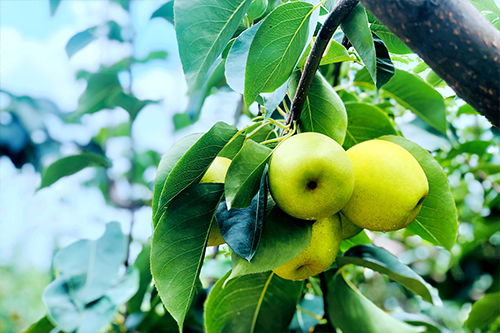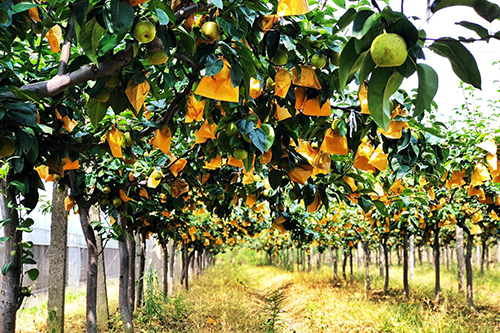

Here we are at the Sino-Japanese Friendly Pear Garden, which was built with Japanese expert, Shigeo Katori and our company together in 2003, covering the area of 50 mu. All varieties and techniques were from Japan. Pear cultivator experts in Chiba Prefecture, Japan, Chiba-shi and KatoShu, will be invited by us every spring and fall to the field for guidance, training and exchange.
The variety with golden peel is the main cultivar of this garden, Fengshui, one of the Japanese "Sanshui" pears that we often hear, is now the most popular variety in the market, showing golden color after bagging. It has few sclereid, delicate meat, more juice, crispy and sweet, is your mouth full of water? Wow, what a big pear! Does anyone know what kind of pear it is? This is Xingao, also a variety of Japan, and this pear can grow to a maximum of 2 kilograms in Japan, like a small watermelon. In addition, there are also Mingshui, Qiuyue, Nanshui, Nanyue, Qiurong and other more than 10 varieties which all come from Japan. The pear matures at early, medium or late, it can last 4 months from July to October. The garden adopts organic cultivation. Our pears are very sweet, in the hot summer, put picked pears in the refrigerator to freeze, and then take out to enjoy, that kind of crisp and cool is absolutely wonderful.
In our garden, what new discoveries have you found except the special varieties? Yes, it is the way of cultivation. Even pear trees can be put on the shelf just like grapes, using the Japanese trellis mode of cultivation. What are the advantages of this trellis mode compared with spinning spindle which is common in China? As we all know, Japan is a coastal country whose wind is particularly strong, so the first advantage of adopting trellis cultivation is to enhance the wind resistance, by fixing the branches on the wire to effectively avoid wind damage to the fruit, which is suitable to high-prevalence area of heavy wind; the second advantage is that it balances the tree vigor. By flattening the branches, the whole tree has the same growth vigor, which can effectively avoid the imbalance of nutrients of the pear tree. In this way, the produced fruit is of the same size and quality. The third advantage is convenient management. We used to pick pears and prune fruit trees in winter by taking ladders to reach the above branches, but now it is simple, we can climb as high as the workers want, and it is convenient to manage. Isn't that interesting?

© Fujiabian agricultural science and technology Sightseeing ParkCopyright Jinicpb19015018-2
Website establishment:南京易云智动科技